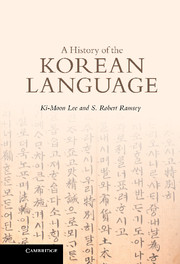Book contents
4 - Early Middle Korean
Published online by Cambridge University Press: 05 June 2012
Summary
The stage of the language known as “Middle Korean” lasted from the tenth century until the end of the sixteenth century. It began with the establishment of the Koryŏ dynasty in AD 918, when the new government moved the capital from Kyŏngju, in the southeast, to Kaegyŏng (later to be renamed Kaesŏng) in the middle of the peninsula. It nominally ended when the Japanese invaded Korea in 1592, and the resulting chaos disrupted the written record of the language.
Middle Korean can be most conveniently divided into two parts: Early Middle Korean and Late Middle Korean. The language of the Koryŏ period (918~1392) is considered to be Early Middle Korean, while the language of the first two hundred years of the Chosŏn period is taken to be Late Middle Korean. That division is not made to mark sweeping changes in the language. On the contrary, political and social developments point more toward linguistic stability than significant change between the Koryŏ and the Chosŏn. At the end of the Koryŏ, in 1392, the founders of the new, Chosŏn dynasty chose a place not very far away to build their capital. Unlike the move from Kyŏngju to Kaesŏng, the move from Kaesŏng to Seoul (then called Hanyang) took place over a relatively short distance and is usually thought to have had a minimal effect on the language. The regional base of the language did not change.
- Type
- Chapter
- Information
- A History of the Korean Language , pp. 77 - 99Publisher: Cambridge University PressPrint publication year: 2011
- 1
- Cited by

